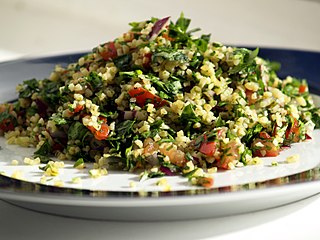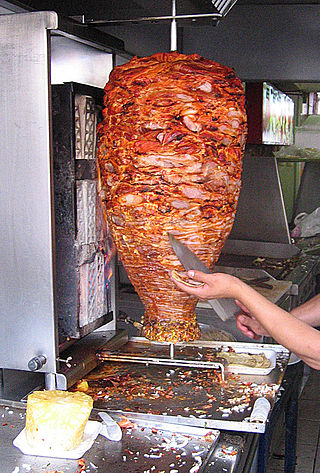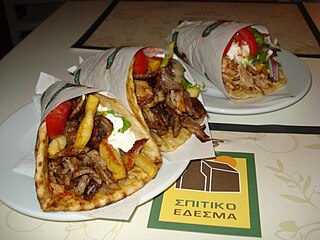
Hummus, also spelled hommus or houmous, is a dip of Arab origin, spread, or savory dish made from cooked, mashed chickpeas blended with tahini, lemon juice, and garlic. The standard garnish in the Middle East includes olive oil, a few whole chickpeas, parsley, and paprika.

Pita or pitta is a family of yeast-leavened round flatbreads baked from wheat flour, common in the Mediterranean, Levant, and neighboring areas. It includes the widely known version with an interior pocket, also known as Arabic bread. In the United Kingdom, Greek bread is used for pocket versions such as the Greek pita, and are used for barbecues as a souvlaki wrap. The Western name pita may sometimes be used to refer to various other types of flatbreads that have different names in their local languages, such as numerous styles of Arab khubz (bread).

Falafel is a deep-fried ball or patty-shaped fritter of Arab origin, featuring in Middle Eastern cuisine made from broad beans, ground chickpeas, or both.

Kebab, kabob, or kebap or kabab is roasted meat that originates from the Middle East but has been popularised by Iranian cuisine & Turkish cuisine. Many variants of the category are popular around the world, including the skewered shish kebab and the doner kebab with bread.

Shawarma is a popular Middle Eastern dish that originated in the Ottoman Empire, consisting of meat cut into thin slices, stacked in an inverted cone, and roasted on a slowly turning vertical rotisserie or spit. Traditionally made with lamb or mutton, it may also be made with chicken, turkey, beef, or veal. Thin slices are shaved off the cooked surface as it continuously rotates. Shawarma is a popular street food in the greater Middle East, including Egypt, Kuwait, Iraq, and the Levant, also served widely in Saudi Arabia.

Steak tartare or tartar steak is a dish of raw ground (minced) beef.

Doner kebab, also spelled as döner kebab, is a dish of Turkish origin made of meat cooked on a vertical rotisserie. Seasoned meat stacked in the shape of an inverted cone is turned slowly on the rotisserie, next to a vertical cooking element. The operator uses a knife to slice thin shavings from the outer layer of the meat as it cooks. The vertical rotisserie was invented in the 19th-century Ottoman Empire, and dishes such as the Arab shawarma, Greek gyros, Canadian donair, and Mexican al pastor are derived from this.

A schnitzel is a thin slice of meat. The meat is usually thinned by pounding with a meat tenderizer. Most commonly, the meat is breaded before frying. Breaded schnitzel is popular in many countries and is made using veal, pork, chicken, mutton, beef, or turkey. Schnitzel is very similar to the dish escalope in France and Spain, panado in Portugal, tonkatsu in Japan, cotoletta in Italy, kotlet schabowy in Poland, milanesa in Latin America, chuleta valluna in Colombia, and chicken-fried steak and pork tenderloin of the United States.

Tabbouleh, also transcribed tabouleh, tabbouli, tabouli, or taboulah, is a Levantine salad made mostly of finely chopped parsley, with tomatoes, mint, onion, soaked uncooked bulgur, and seasoned with olive oil, lemon juice, salt and sweet pepper. Some variations add lettuce, or use semolina instead of bulgur.

Kibbeh, İçli köfte in Türkiye, Koupes in Cyprus, is a family of dishes based on spiced ground meat, onions, and grain, popular in many countries of West Asia.

Al pastor, tacos al pastor, or tacos de trompo is a preparation of spit-grilled slices of pork originating in the Central Mexican region of Puebla and Mexico City, although today it is a common menu item found in taquerías throughout Mexico. The method of preparing and cooking al pastor is based on the lamb shawarma brought by Lebanese immigrants to the region. Al pastor features a flavor palate that uses traditional Mexican adobada (marinade). It is a popular street food that has spread to the United States. In some places of northern Mexico and coastal Mexico, such as in Baja California, taco al pastor is known as taco de trompo or taco de adobada.

Levantine cuisine is the traditional cuisine of the Levant, in the sense of the rough area of former Ottoman Syria. The cuisine has similarities with Egyptian cuisine, North African cuisine and Ottoman cuisine. It is particularly known for its meze spreads of hot and cold dishes, most notably among them ful medames, hummus, tabbouleh and baba ghanoush, accompanied by bread.

Musakhan, also known as muhammar, is a Palestinian dish composed of roasted chicken baked with onions, sumac, allspice, saffron, and fried pine nuts served over taboon bread. Originating in the Tulkarm and Jenin area, musakhan is often considered the national dish of Palestine. The dish is particularly popular among Palestinians, Israeli Arabs and Jordanians. In Israel, it is eaten by Israeli Arabs and Israeli Druze in Galilee, especially around Iksal and Sandala, and in the Triangle. The dish can be found in Syria, Lebanon and Jordan as well.

Sabich or sabih is a sandwich of pita or laffa bread stuffed with fried eggplants, hard boiled eggs, chopped salad, parsley, amba and tahini sauce. It is an Iraqi Jewish dish that has become a staple of Israeli cuisine, as a result of Iraqi Jewish immigration to Israel. Its ingredients are based on a traditional quick breakfast of Iraqi Jews and is traditionally made with laffa, which is nicknamed Iraqi pita. Sabich is sold in many businesses throughout Israel.

Yemeni cuisine is distinct from the wider Middle Eastern cuisines, but with a degree of regional variation. Although some foreign influences are evident in some regions of the country, the Yemeni kitchen is based on similar foundations across the country.

Somali cuisine has moderate foreign influence from different countries mainly due to trade, but traditionally also varies from region to region due to the expansive landmass Somalis inhabit. It is the product of Somalia's tradition of trade and commerce. Some notable Somali specialties include kimis/sabaayad, canjeero/lahoh, xalwo (halwa), sambuusa (samosa), bariis iskukaris, and muqmad/odkac.

A chicken sandwich is a sandwich that typically consists of boneless, skinless chicken breast or thigh served between slices of bread, on a bun, or on a roll. Variations on the "chicken sandwich" include the chicken burger, chicken on a bun, chickwich, hot chicken, or chicken salad sandwich.

Israeli cuisine comprises both local dishes and dishes brought to Israel by Jews from the diaspora. Since before the establishment of the State of Israel in 1948, and particularly since the late 1970s, an Israeli Jewish fusion cuisine has developed.

The McArabia is a pita bread sandwich available at all McDonald's outlets in Arab countries and Pakistan. It is known as the Grilled Chicken foldover in Singapore, Malaysia and South Africa, as McOriental in Spain, France and Holland, the McTurco in Turkey, Greek Mac in Greece and Cyprus, and as the McKebab in Israel. The sandwich was originally made to meet West Asian local taste.

Greek-American cuisine is the cuisine of Greek Americans and their descendants, who have modified Greek cuisine under the influence of American culture and immigration patterns of Greeks to the United States. As immigrants from various Greek areas settled in different regions of the United States and became "Greek Americans," they carried with them different traditions of foods and recipes that were particularly identified with their regional origins in Greece and yet infused with the characteristics of their new home locale in America. Many of these foods and recipes developed into new favorites for town peoples and then later for Americans nationwide. Greek-American cuisine is especially prominent in areas of concentrated Greek communities, such as Astoria, Queens and Tarpon Springs, Florida.




















